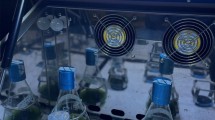Abstract
Three different dissolved oxygen (DO) control approaches were proposed to improve hyaluronic acid (HA) production: a three-stage agitation speed control approach, a two-stage DO control approach, and an oxygen vector perfluorodecalin (PFC) applied approach. In the three-stage agitation speed control approach, agitation speed was 200 rpm during 0–8 h, 400 rpm during 8–12 h, and 600 rpm during 12–20 h. In the two-stage DO control strategy, DO was controlled at above 10% during 0–8 h and at 5% during 8–20 h. In the PFC applied approach, PFC (3% v/v) was added at 8 h. HA production reached 5.5 g/L in the three-stage agitation speed control culture model, and 6.3 g/L in two-stage DO control culture model, and 6.6 g/L in the PFC applied culture model. Compared with the other two DO control approaches, the PFC applied approach had a lower shear stress and thus a higher HA production was achieved.






Similar content being viewed by others
References
Laurent TC, Laurent UB, Fraser JR (1996) The structure and function of hyaluronan: an overview. Immunol Cell Biol 74:1–7
Peyron JG (1993) A new approach to the treatment of osteoarthritis: viscosupplementation. Osteoarthr Cartil 1:85–87
Lapcik L, De Smedt S, Demeester J, Chabrecek P (1998) Hyaluronan: preparation, structure, properties, and applications. Chem Rev 98:2663–2684
Morra M (2005) Engineering of biomaterials surfaces by hyaluronan. Biomacromolecules 6:1205–1223
Park SN, Lee HJ, Lee KH, Suh H (2003) Biological characterization of EDC cross-linked collagen–hyaluronic acid matrix in dermal tissue restoration. Biomaterials 24:1631–1641
Esposito E, Menegatti E, Cortesi R (2005) Hyaluronan-based microspheres as tools for drug delivery: a comparative study. Int J Pharm 288:35–49
Huang WC, Chen SJ, Chen TL (2008) Production of hyaluronic acid by repeated batch fermentation. Biochem Eng J 40:460–464
Hasegawa S, Nagatsuru M, Shibutani M, Yamamoto S, Hasebe S (1999) Productivity of concentrated hyaluronic acid using maxblend fermentor. J Biosci Bioeng 88:68–71
Gao HJ, Du GC, Chen J (2006) Analysis of metabolic fluxes for hyaluronic acid (HA) production by Streptococcus zooepidemicus. World J Microbiol Biotechnol 22:399–408
Liu L, Wang M, Du GC, Chen J (2008) Enhanced hyaluronic acid production of Streptococcus zooepidemicus by an intermittent alkaline-stress strategy. Lett Appl Microbiol 46:383–388
Kim JH, Deok-Kun SY (1996) Selection of a Streptococcus equi mutant and optimization of culture conditions for the production of high molecular weight hyaluronic acid. Enzyme Microbiol Technol 19:440–445
Kim SJ, Park SY, Kim CW (2006) A novel approach to the production of hyaluronic acid by Streptococcus zooepidemicus. J Microbiol Biotechnol 16:1849–1855
Liu L, Wang M, Du GC, Chen J, Sun J (2008) Influence of culture modes on the microbial production of hyaluronic acid by Streptococcus zooepidemicus. Biotechnol Bioproc E 13:269–273
Liu L, Wang M, Du GC, Chen J, Sun J (2008) Enhanced hyaluronic acid production by a two-stage culture strategy based on the modeling of batch and fed-batch cultivation of Streptococcus zooepidemicus. Bioresour Technol 99:8532–8536
Bitter H, Muir HM (1962) A modified uronic acid carbazole reaction. Anal Biochem 4:330–334
Chisti Y, Jauregui-Haza UJ (2002) Oxygen transfer and mixing in mechanically agitated airlift bioreactors. Biochem Eng J 10:143–153
Serrano CL, Corona RM, Sanchez A, Galindo E (1998) Prediction of xanthan fermentation development by a model linking kinetics, power drawn and mixing. Process Biochem 22:133–146
Elibol M, Ozer D (2000) Influence of oxygen transfer on lipase production by Rhizopusarrhizus. Process Biochem 36:325–329
Richard A, Margaritis A (2003) Rheology, oxygen transfer, and molecular weight characteristics of poly (glutamic acid) fermentation by Bacillus subtilis. Biotechnol Bioeng 89:299–305
Rodríguez-Monroy M, Galindo E (1998) Broth rheology, growth and metabolite production of Beta vulgaris suspension culture: a comparative study between cultures grown in shake flasks and in a stirred tank. Enzyme Microbiol Technol 24:687–693
Casas JA, Santos VE, García-Ochoa F (2000) Xanthan gum production under several operational conditions: molecular structure and rheological properties. Enzyme Microbiol Technol 26:282–291
Ryu DY, Humphrey AE (1972) A reassessment of oxygen transfer rates in antibiotics fermentations. J Ferm Technol 50:424–431
Yagi H, Yoshida F (1975) Gas absorption by Newtonian and non-Newtonian fluids in sparged agitated vessels. Ind Eng Chem Proc Des Dev 14:488–493
Huang WC, Chen SJ, Chen TL (2006) The role of dissolved oxygen and function of agitation in hyaluronic acid fermentation. Biochem Eng J 32:239–243
Liu L, Wang M, Du GC, Chen J, Sun J (2009) Microbial production of low molecular weight hyaluronic acid by adding hydrogen peroxide and ascorbate in batch culture of Streptococcus zooepidemicus. Bioresour Technol 100:362–367
Cleary PP, Larkin A (1979) Hyaluronic acid capsule: strategy for oxygen resistance in group A Streptococci. J Bacteriol 140:1090–1097
Elibol M, Mavituna F (1999) A remedy to oxygen limitation problem in antibiotic production: addition of perfluorocarbon. Biochem Eng J 3:1–7
Wilhelm E, Battino R (1986) The solubility of gases in liquids. 17. The solubility of gases in carbon tetrachloride. Chem Rev 73:214–220
Gotoh T, Mochizuki G, Kikuchi KI (2001) A novel column fermentor having a wetted-wall of perfluorocarbon as an oxygen carrier. Biochem Eng J 8:165–169
Zhang JY, Ning Hao, Chen GQ (2006) Effect of expressing polyhydroxybutyrate synthesis genes (phbCAB) in streptococcus zooepidemicus on production of lactic acid and hyaluronic acid. Appl Microbiol Biotechnol 71:221–227
Acknowledgments
This project was financially supported by Program for Changjiang Scholars and Innovative Research Team in University (No. IRT0532), the National Science Fund for Distinguished Young Scholars of China (No. 20625619), Program for Cultivation and Innovation of Graduate Students in Jiangsu Province (CX08B_128Z), and 973 Project (2007CB714306).
Author information
Authors and Affiliations
Corresponding authors
Rights and permissions
About this article
Cite this article
Liu, L., Du, G., Chen, J. et al. Comparative study on the influence of dissolved oxygen control approaches on the microbial hyaluronic acid production of Streptococcus zooepidemicus . Bioprocess Biosyst Eng 32, 755–763 (2009). https://doi.org/10.1007/s00449-009-0300-6
Received:
Accepted:
Published:
Issue Date:
DOI: https://doi.org/10.1007/s00449-009-0300-6




